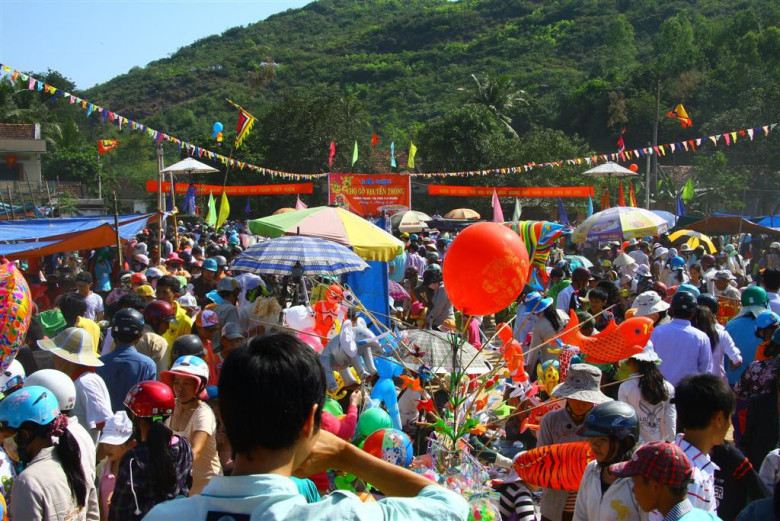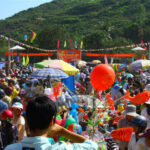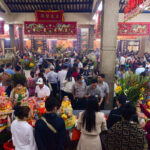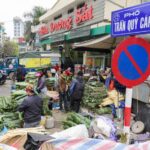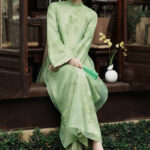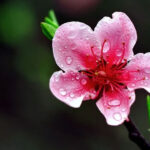A Unique Market That Opens on the First Day of Tet
Go Market is situated on a small hill at the foot of Truong Uc Mountain, along the Ha Thanh River that flows into Thi Nai Lagoon. Despite being called a market, it is actually just an open space with no permanent stalls or shops. Throughout the year, no trading activities take place here, except for a single market session on the first day of Tet.
According to legend, Go Market originated during the time of the Tay Son brothers’ uprising. This area used to be a military training ground for infantry based at Truong Uc Mountain and naval forces from Thi Nai Lagoon. To dispel homesickness during Tet, the Tay Son generals organized festivities on the training ground on the first day of the new year.
It is said that the soldiers and their families enjoyed themselves until sunset, after which the soldiers returned to their guard duties while their families headed home. This became an annual tradition, with the soldiers’ families gathering here every year on the first day of spring, bringing local specialties to exchange.
Over time, this custom became a ritual. Even after the fall of the Tay Son dynasty, the locals continued to maintain this tradition as an annual spring festival.
During the French colonial period, due to restrictions on large gatherings, the market sometimes had to be held at night. Despite heavy rains or floods, the people persevered and braved the elements to attend the market, standing in the water to sell their goods.
Thanks to the community’s dedication to preserving the rustic charm of this country market, Go Market has survived for centuries. It serves as a tribute to the Tay Son generals and also symbolizes the community’s aspirations for joy and good fortune in the new year.
Buying Luck and Seeking Love
Unlike ordinary markets, Go Market resembles a spring festival. As soon as the Lunar New Year’s Eve fireworks end, people from all over bring local specialties such as vegetables, fruits, and food products, but the most common items are betel and areca nuts.
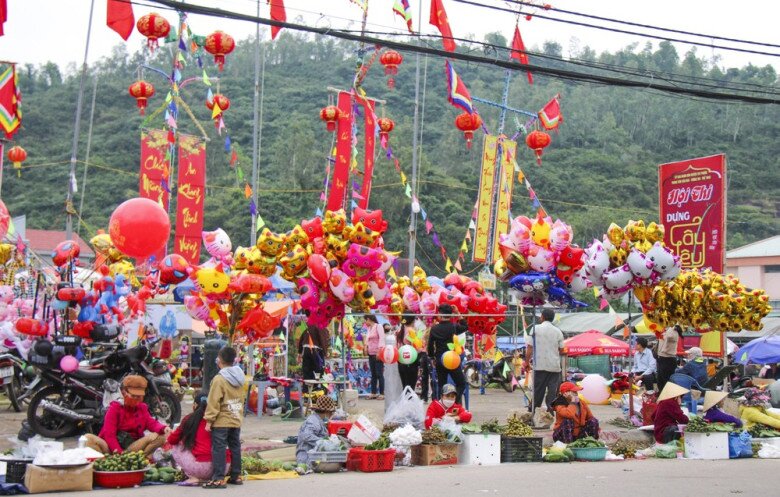
Following customs, customers usually buy 12 betel leaves representing the 12 months of the year, two areca nuts, some slaked lime from Truong Uc Mountain, and a cluster of figs symbolizing abundance and wealth. The betel and areca nuts are typically placed on the ancestral altar or used for fortune-telling. Many people also bring these items to the graves on Truong Uc Mountain.
Salt is another popular item, as the saying goes, “Buy salt at the beginning of the year and slaked lime at the end.” Interestingly, no one haggles over prices at this market. The buying and selling here are more about exchanging lucky tokens and wishing each other prosperity for the year ahead.
A unique aspect of this market is that young couples often come here to buy betel, areca nuts, and slaked lime as a way of seeking romantic blessings. Many couples have found their life partners through this special market.
Apart from buying lucky tokens, visitors also participate in folk games such as hat boi (classical Vietnamese opera), hat bai choi (a game involving singing and lottery tickets), walking on stilts, martial arts performances, and human chess.
The tradition of writing lucky red couplets at Go Market is also preserved. Elderly scholars, wearing traditional headwear and robes, sit and write couplets on red paper, creating a scene that embodies the essence of Tet traditions.
A Unique Cultural Feature of the “Land of Martial Arts”
Despite only operating for one day a year, Go Market embodies the rich cultural heritage of the nation. It stands out among thousands of markets and has been ranked among the “100 Most Unique Markets in Vietnam” by the Vietnam Records Book Center.
Go Market is the largest spring festival in Binh Dinh Province and has been preserved for centuries as a unique community cultural feature. With its historical value and profound cultural significance, the local government is gathering historical documents to propose the recognition of Go Market as an intangible cultural heritage of the nation.
The Weird and Wonderful New Year’s Day Market: Ranked among “Vietnam’s 100 Most Unique Markets”
Chợ Gò is a unique market that springs to life on the first day of the Lunar New Year in the land of Binh Dinh, renowned for its martial arts and literary heritage. Steeped in history, dating back to the era of the Tay Son brothers’ uprising, this market is more than just a place for commerce and the exchange of New Year blessings. It is a vibrant hub where traditional values and the festive spirit of spring converge, leaving an indelible mark on the cultural landscape of this region.
The Heart of Hanoi: A Bustling Old Market with a Single, Thriving Offering that Draws Crowds During Tet
The days leading up to the Lunar New Year 2025 were a bustling time for the leaf market on Tran Quy Cap Street in Hanoi. Leaves from all over the region were brought to this vibrant street, transforming it into a sea of green as locals prepared to make their traditional Chung cakes for the festive season.
The Ultimate Guide to Choosing and Caring for Peach Blossoms this Lunar New Year to Invite Prosperity into Your Home
The tradition of displaying peach blossoms during the Tet holiday, a time of celebration and renewal in Vietnamese culture, is steeped in symbolism and significance. For generations, families have meticulously selected and adorned their homes with these delicate blooms, believing they bring joy and good fortune for the coming year. This ritualistic practice of welcoming spring and its promise of new beginnings through the beauty of nature is a cherished custom, unique to the Tet festival, and an integral part of bringing the festive spirit into Vietnamese homes.

























